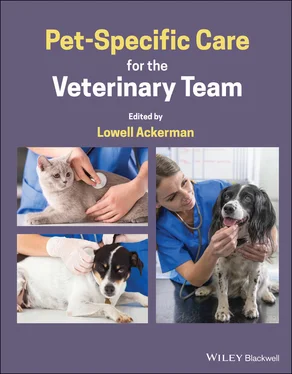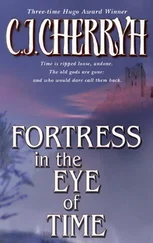prostatic neoplasia [6]
transitional cell carcinoma (TCC) [34, 35]
osteosarcoma [36, 37]
cranial cruciate ligament rupture (CCLR) [14].
Timing of gonadectomy may also influence a patient's predisposition to orthopedic disease [6, 14]. A recent study of 1842 dogs suggests that dogs neutered before 5 months of age have an increased incidence of hip dysplasia [4, 14].
Interest in reversible contraceptive methods continues to build but its efficacy and the potential for adverse effects remain concerns.
1 1 Farnworth, M.J., Adams, N.J., Seksel, K. et al. (2013). Veterinary attitudes towards pre‐pubertal gonadectomy of cats: a comparison of samples from New Zealand, Australia and the United Kingdom. N. Z. Vet. J. 61: 226–233.
2 2 Pet Statistics. (2019). www.aspca.org/animal‐homelessness/shelter‐intake‐and‐surrender/pet‐statistics
3 3 Asa, C.S. (2018). Contraception in dogs and cats. Vet. Clin. North Am. Small Anim. Pract. 48: 733–742.
4 4 Spain, C.V., Scarlett, J.M., and Houpt, K.A. (2004). Long‐term risks and benefits of early‐age gonadectomy in dogs. J. Am. Vet. Med. Assoc. 224: 380–387.
5 5 Lieberman, L.L. (1987). A case for neutering pups and kittens at two months of age. J. Am. Vet. Med. Assoc. 191: 518–521.
6 6 Kustritz, M.V.R. (2007). Determining the optimal age for gonadectomy of dogs and cats. J. Am. Vet. Med. Assoc. 231: 1665–1675.
7 7 Alexander, S.A. and Shane, S.M. (1994). Characteristics of animals adopted from an animal control center whose owners complied with a spaying/neutering program. J. Am. Vet. Med. Assoc. 205: 472–476.
8 8 Spain, C.V., Scarlett, J.M., and Cully, S.M. (2002). When to neuter dogs and cats: a survey of New York state veterinarians' practices and beliefs. J. Am. Anim. Hosp. Assoc. 38: 482–488.
9 9 Kustritz, M.V.R. (2014). Pros, cons, and techniques of pediatric neutering. Vet. Clin. North Am. Small Anim. Pract. 44: 221–233.
10 10 Reichler, I.M. (2009). Gonadectomy in cats and dogs: a review of risks and benefits. Reprod. Domest. Anim. 44: 29–35.
11 11 Schneider, R., Dorn, C.R., and Taylor, D.O. (1969). Factors influencing canine mammary cancer development and postsurgical survival. J. Natl. Cancer Inst. 43: 1249–1261.
12 12 Hayes, H.M. Jr., Milne, K.L., and Mandell, C.P. (1981). Epidemiological features of feline mammary carcinoma. Vet. Rec. 108: 476–479.
13 13 Misdorp, W. (1988). Canine mammary tumours: protective effect of late ovariectomy and stimulating effect of progestins. Vet. Q. 10: 26–33.
14 14 Reichler, I.M. (2009). Gonadectomy in cats and dogs: a review of risks and benefits. Reprod. Domest. Anim. 44 (Suppl 2): 29–35.
15 15 Kustritz, M.V.R. (1996). Elective gonadectomy in the cat. Feline Pract. 24: 36–39.
16 16 Faggella, A.M. and Aronsohn, M.G. (1994). Evaluation of anesthetic protocols for neutering 6‐ to 14‐week‐old pups. J. Am. Vet. Med. Assoc. 205: 308–314.
17 17 Howe, L.M. (1997). Short‐term results and complications of prepubertal gonadectomy in cats and dogs. J. Am. Vet. Med. Assoc. 211: 57–62.
18 18 van Goethem, B., Schaefers‐Okkens, A., and Kirpensteijn, J. (2006). Making a rational choice between ovariectomy and ovariohysterectomy in the dog: a discussion of the benefits of either technique. Vet. Surg. 35: 136–143.
19 19 DeTora, M. and McCarthy, R.J. (2011). Ovariohysterectomy versus ovariectomy for elective sterilization of female dogs and cats: is removal of the uterus necessary? J. Am. Vet. Med. Assoc. 239: 1409–1412.
20 20 Salmeri, K.R., Bloomberg, M.S., Scruggs, S.L. et al. (1991). Gonadectomy in immature dogs: effects on skeletal, physical, and behavioral development. J. Am. Vet. Med. Assoc. 198: 1193–1203.
21 21 Goericke‐Pesch, S. (2010). Reproduction control in cats: new developments in non‐surgical methods. J. Feline Med. Surg. 12: 539–546.
22 22 Agudelo, C.F. (2005). Cystic endometrial hyperplasia‐pyometra complex in cats. A review. Vet. Q. 27: 173–182.
23 23 Volpe, P., Izzo, B., Russo, M. et al. (2001). Intrauterine device for contraception in dogs. Vet. Rec. 149: 77–79.
24 24 Wiebe, V.J. and Howard, J.P. (2009). Pharmacologic advances in canine and feline reproduction. Top. Compan. Anim. Med. 24: 71–99.
25 25 Kutzler, M. and Wood, A. (2006). Non‐surgical methods of contraception and sterilization. Theriogenology 66: 514–525.
26 26 Levy, J.K., Crawford, P.C., Appel, L.D. et al. (2008). Comparison of intratesticular injection of zinc gluconate versus surgical castration to sterilize male dogs. Am. J. Vet. Res. 69: 140–143.
27 27 Oliveira, E.C., Fagundes, A.K., Melo, C.C. et al. (2013). Intratesticular injection of a zinc‐based solution for contraception of domestic cats: a randomized clinical trial of efficacy and safety. Vet. J. 197: 307–310.
28 28 Oliveira, E.C., Moura, M.R., de Sa, M.J. et al. (2012). Permanent contraception of dogs induced with intratesticular injection of a zinc gluconate‐based solution. Theriogenology 77: 1056–1063.
29 29 Massei, G. and Miller, L.A. (2013). Nonsurgical fertility control for managing free‐roaming dog populations: a review of products and criteria for field applications. Theriogenology 80: 829–838.
30 30 Fagundes, A.K., Oliveira, E.C., Tenorio, B.M. et al. (2014). Injection of a chemical castration agent, zinc gluconate, into the testes of cats results in the impairment of spermatogenesis: a potentially irreversible contraceptive approach for this species? Theriogenology 81: 230–236.
31 31 Vanderstichel, R., Forzan, M.J., Perez, G.E. et al. (2015). Changes in blood testosterone concentrations after surgical and chemical sterilization of male free‐roaming dogs in southern Chile. Theriogenology 83: 1021–1027.
32 32 Paranzini, C.S., Sousa, A.K., Cardoso, G.S. et al. (2018). Effects of chemical castration using 20% CaCl2 with 0.5% DMSO in tomcats: evaluation of inflammatory reaction by infrared thermography and effectiveness of treatment. Theriogenology 106: 253–258.
33 33 Pollari, F.L., Bonnett, B.N., Bamsey, S.C. et al. (1996). Postoperative complications of elective surgeries in dogs and cats determined by examining electronic and paper medical records. J. Am. Vet. Med. Assoc. 208: 1882–1886.
34 34 Knapp, D.W., Glickman, N.W., Denicola, D.B. et al. (2000). Naturally‐occurring canine transitional cell carcinoma of the urinary bladder a relevant model of human invasive bladder cancer. Urol. Oncol. 5: 47–59.
35 35 Norris, A.M., Laing, E.J., Valli, V.E. et al. (1992). Canine bladder and urethral tumors: a retrospective study of 115 cases (1980–1985). J. Vet. Intern. Med. 6: 145–153.
36 36 Priester, W.A. and McKay, F.W. (1980). The occurrence of tumors in domestic animals. Natl. Cancer Inst. Monogr.: 1–210.
37 37 Ru, G., Terracini, B., and Glickman, L.T. (1998). Host related risk factors for canine osteosarcoma. Vet. J. 156: 31–39.
1 Asa, C.S. (2018). Contraception in dogs and cats. Vet. Clin. North Am. Small Anim. Pract. 48: 733–742.
2 Goerick‐Pesch, S. (2010). Reproduction control in cats: new developments in non‐surgical methods. J. Feline Med. Surg. 12: 539–546.
3 Kustritz, M.V. (2014). Pros, cons, and techniques of pediatric neutering. Vet. Clin. North Am. Small Anim. Pract. 44: 221–233.
4 Wiebe, V.J. (2009). Pharmacologic advances in canine and feline reproduction. Top. Compan. Anim. Med. 24 (2): 71–99.
Donna L. Harris, DVM, MBA, MS(Strategic Foresight)
College of Veterinary Medicine, Michigan State University, East Lansing, MI, USA
 BASICS
BASICS
Читать дальше

 BASICS
BASICS










